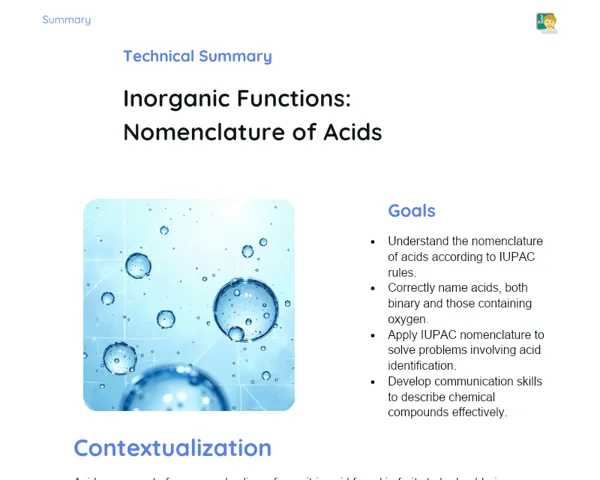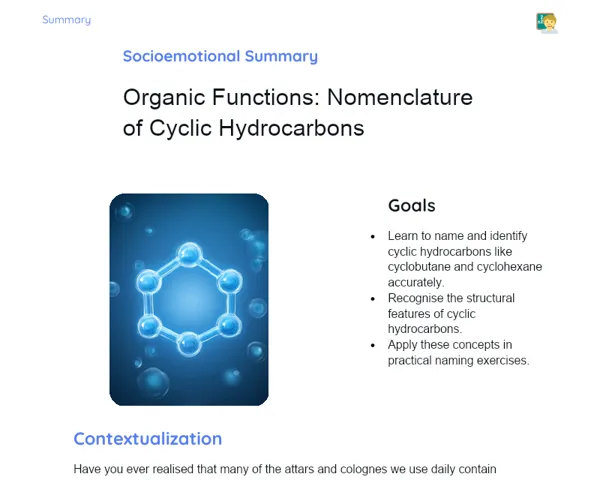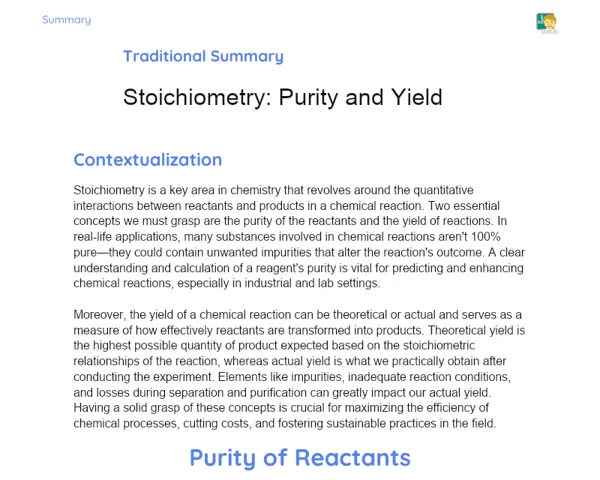Summary Tradisional | Dissociation and Ionization
Contextualization
Chemistry is the study of matter and its changes. Two important processes that help us understand how different substances behave in water are dissociation and ionization. In dissociation, an ionic compound splits into its constituent ions when it dissolves in water, keeping its basic ionic character intact. In contrast, ionization involves a covalent molecule breaking down to form new ions once dissolved in water.
These processes are not just limited to textbooks – we encounter them daily. For example, table salt (NaCl) splits into sodium (Na+) and chloride (Cl-) ions when mixed with water, while hydrochloric acid (HCl), which is present in our stomach secretions, ionizes into hydrogen (H+) and chloride (Cl-) ions to help us digest food. Grasping the concepts of dissociation and ionization is key to understanding how solutions conduct electricity, the activity of acids and bases, and various industrial as well as biological applications.
To Remember!
Definition of Dissociation
Dissociation is the process where an ionic compound splits into its ions when dissolved in water. In doing so, the ions that were already part of the original compound become free to move in the solution. This is a crucial concept when examining how substances behave in a watery medium, especially with regard to their reactivity and ability to conduct electricity.
Take sodium chloride (NaCl) as an example: when it dissolves in water, it dissociates into sodium ions (Na+) and chloride ions (Cl-). These free-moving ions allow the solution to conduct electricity, a basic principle that finds applications in things like batteries and electrolysis setups.
It is important to note that while the arrangement of the ions changes during dissociation, their chemical nature remains the same, thereby letting them take part in subsequent chemical reactions.
-
Dissociation involves ionic compounds splitting into their ions.
-
The ions keep their inherent chemical properties.
-
This process enables the conduction of electricity in water.
Definition of Ionization
Ionization refers to the chemical process in which covalent molecules break apart to form ions when dissolved in water. Unlike dissociation, here new ions are formed that were not present in the original molecule. This process is vital for evaluating how acids and bases behave in solution.
A familiar example is hydrochloric acid (HCl). When HCl is dissolved in water, it ionizes into hydrogen ions (H+) and chloride ions (Cl-). This ionization is crucial not just in industrial processes but also in our own bodies, for instance, in the stomach where it aids digestion.
The key point is that the ions produced by ionization often have different chemical properties than the healthy neutral molecules they originated from, which impacts both the acidity and reactivity of the solution.
-
Ionization results in the formation of new ions from covalent molecules.
-
The new ions may exhibit different chemical properties.
-
It is an essential process for the active behavior of acids and bases.
Differences Between Dissociation and Ionization
The fundamental difference between dissociation and ionization lies in the types of compounds involved and the nature of the ions produced. In dissociation, ionic compounds like salts break into ions that already existed as part of the compound. In ionization, covalent molecules such as acids break down to form entirely new ions.
Typically, dissociation is seen in salts and strong bases, whereas ionization is more common with weak acids and bases. For instance, sodium hydroxide (NaOH) dissociates into sodium (Na+) and hydroxide (OH-) ions, while acetic acid (CH3COOH) ionizes into hydrogen (H+) and acetate (CH3COO-) ions.
Recognising these differences is important for understanding the conductivity, reactivity, and various chemical behaviours in aqueous solutions.
-
Dissociation occurs with ionic compounds; ionization happens with covalent molecules.
-
In dissociation, the ions are pre-existing in the compound.
-
Ionization generates new ions from neutral molecules.
Importance of the Processes
Both dissociation and ionization are central to the conduction of electricity through solutions, a principle that underpins many technological applications – from the operation of batteries to various industrial processes. For example, fuel cells and other electrochemical devices rely on these processes to function effectively.
Moreover, the reactivity of acids and bases in solutions is closely tied to these processes. Strong acids like sulfuric acid (H2SO4) ionize completely, thus releasing a large number of hydrogen ions (H+), which makes them highly reactive. Similarly, strong bases such as sodium hydroxide (NaOH) also dissociate completely, freeing hydroxide ions (OH-) that participate in many reactions.
From a biological perspective, both dissociation and ionization are vital. Consider how carbonic acid (H2CO3) ionizes into hydrogen (H+) and bicarbonate (HCO3-) ions – one of the body’s mechanisms to regulate blood pH.
-
These processes are essential for electrical conduction in solutions.
-
The activity of acids and bases hinges on dissociation and ionization.
-
They play a key role in several vital biological functions.
Key Terms
-
Dissociation: Process by which ionic compounds split into ions when dissolved in water.
-
Ionization: Process in which covalent molecules break apart to form ions when dissolved in water.
-
Ionic Compounds: Substances made up of ions that dissociate in water.
-
Covalent Compounds: Substances formed by atoms sharing electrons that may undergo ionization in water.
-
Aqueous Solutions: Mixtures in which water acts as the solvent.
-
NaOH: Sodium hydroxide, common example of a compound that dissociates in water.
-
HCl: Hydrochloric acid, typical example of a compound that ionizes in water.
-
Reactivity: The tendency of a substance to engage in chemical reactions.
-
Electrical Conductivity: The ability of a solution to conduct electricity, aided by the presence of free ions.
Important Conclusions
In summary, dissociation and ionization are essential concepts for understanding the behavior of substances in water. While dissociation involves the separation of ionic compounds into their pre-existing ions, ionization is the process in which covalent molecules break down to generate new ions. Both these processes are critical in explaining how solutions conduct electricity, as well as the reactivity of acids and bases in various practical contexts.
This understanding is not just theoretical – it has real-world implications ranging from the functioning of electrical devices like batteries to important processes such as digestion. It is thus highly beneficial for students to explore these topics further, as a solid grasp of these concepts enhances their overall understanding of Chemistry and Natural Sciences.
Study Tips
-
Revise the definitions of dissociation and ionization, along with the real-life examples discussed.
-
Practice identifying compounds that dissociate or ionize in different scenarios using exercises and sample questions.
-
Watch videos and explore additional resources that bring these processes to life and help reinforce the learning.



